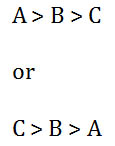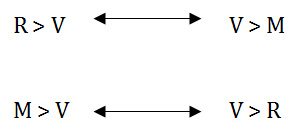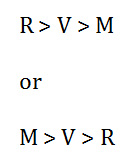If you’ve taken any test from the last couple of years, you may have stumbled upon strangely-worded or confusing rules. For example:
Train A can arrive earlier than train B if and only if train B arrives earlier than train C.Either car A arrives immediately before car B, or it arrives immediately after car C, but not both.
The Q meal is served at some time after either the M meal or the N meal, but not after both.
It’s worth noting that none of these rules is ambiguous, i.e. none of it is open to multiple interpretations. That would compromise the logical validity and reliability of the exam, which is not something test-makers ever want to do. Indeed, each of these rules entails a concrete and definitive outcome: it’s just that this outcome is not as easy to deduce as it is with more straightforward rules.
Let’s analyze the first rule:
Train A can arrive earlier than train B if and only if train B arrives earlier than train C.
This is clearly a conditional statement, which many test-takers would diagram as follows:
By the contrapositive, train C can arrive earlier than train B if and only if train B can arrive earlier than train A (assuming none of the trains can arrive simultaneously):
These two diagrams show that you possess the conditional reasoning skills necessary to ace the test. Unfortunately, this is not enough to ace it: ironically, knowledge of conditional reasoning is a necessary, but not a sufficient, condition to do well. What you need to do is analyze each part of this bi-conditional relationship more closely:
Let’s take trains A and B. Assuming neither of them can arrive simultaneously, there are only two possible sequences for A and B:
Our conditional rule specifies exactly what each of these two sequences mean: in the first one, train B must arrive before train C; in the second one, the opposite is true. Thus, we can create two separate, exhaustive, and mutually exclusive sequencing rules, one of which will always govern the order in which the three trains arrive:
This is a much simpler representation of the original rule: it’s easier to understand, and even easier to apply to the questions in the game. It also shows you an important inference that you may not have seen otherwise: the B train can never arrive first or last.
When faced with trickier rules, the goal is to simplify them without deviating from their original meaning. Avoid parroting (or restating) the rule written on the page: try to analyze what it means, visually as well as spatially. And if it still seems convoluted, remember: there is usually a simpler way to draw it out.
Now let’s analyze another conditional rule frequently encountered in Linear Games. This rule is particularly prone to misinterpretation:
The Victorian painting must be restored later in the week than the Renaissance painting or later in the week than the Modernist painting, but not both.
Notice that the rule has two parts:
- The Victorian painting must be restored later in the week than the Renaissance painting OR later in the week than the Modernist painting.
The first part of the rule has the classic form of an “either/or” statement, outlining two possible sequences—R > V or M > V—one of which must always occur. So, if the first sequence does not occur, i.e. if the Victorian painting is NOT restored later in the week than the Renaissance painting, then it must be restored later in the week than the Modernist painting:
By the contrapositive, if the Victorian painting is NOT restored later in the week than the Modernist painting, then it must be restored later in the week than the Renaissance painting:
- The Victorian painting CANNOT be restored later in the week than both the Renaissance painting and the Modernist painting
According to the second half of the rule, the two sequences outlined above CANNOT occur simultaneously. So, if the first sequence does occur, i.e. if the Victorian painting is restored later in the week than the Renaissance painting, then it CANNOT be restored later in the week than the Modernist painting:
By the contrapositive, if the Victorian painting is restored later in the week than the Modernist painting, then it CANNOT be restored later in the week than the Renaissance painting:
When combined, the two parts of this rule produce the following conditional relationship between the M > V and R > V sequences:
Assuming that no two paintings can be restored simultaneously, we can simplify the diagram by eliminating any negated terms:
Thus, we can create two separate, exhaustive, and mutually exclusive sequencing chains, one of which will always govern the order in which the three paintings are being restored:
This is a much simpler representation of the original rule, showing us an important inference that you may not have seen otherwise: the Victorian painting can never be the first or the last painting restored that week.
After you practice with this type of rule a few times, you can probably jump straight into creating the two sequencing chains without diagramming the original conditional statements. While there is always the danger of misinterpretation, as long as you understand the precise conditional relationship between each two pairs of sequencing rules you should not forfeit accuracy for the sake of speed. Indeed, superior conceptual understanding does not automatically entail more time spent analyzing the rule in question: on the contrary, over time, this understanding will enable you to formulate ever more quickly the concrete and definitive outcome of the rules governing the composition of variables in your game.




